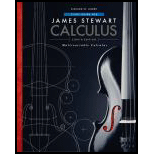
Study Guide for Stewart's Multivariable Calculus, 8th
8th Edition
ISBN: 9781305271845
Author: Stewart, James
Publisher: Brooks Cole
expand_more
expand_more
format_list_bulleted
Textbook Question
Chapter 16.5, Problem 4PT
True or False:
div curl F = 0.
Expert Solution & Answer
Want to see the full answer?
Check out a sample textbook solution
Students have asked these similar questions
HW: The frame shown in the figure is pinned at A and
C. Use moment distribution method, with and without
modifications, to draw NFD, SFD, and BMD.
B
I
I
40 kN/m
A
3 m
4 m
Let the region R be the area enclosed by the function f(x)= = 3x² and g(x) = 4x. If the region R is the
base of a solid such that each cross section perpendicular to the x-axis is an isosceles right triangle with a
leg in the region R, find the volume of the solid. You may use a calculator and round to the nearest
thousandth.
y
11
10
9
00
8
7
9
5
4
3
2
1
-1
-1
x
1
2
Let the region R be the area enclosed by the function f(x) = ex — 1, the horizontal line y = -4 and
the vertical lines x = 0 and x = 3. Find the volume of the solid generated when the region R is revolved
about the line y = -4. You may use a calculator and round to the nearest thousandth.
20
15
10
5
y
I
I
I
|
I
+
-1.5
-1
-0.5
0.5
1
1.5
2
2.5
3
-5
I
-10
-15
I
+
I
I
T
I
I
+
-20
I
+
-25
I
I
I
-30
I
3.5
4
x
Chapter 16 Solutions
Study Guide for Stewart's Multivariable Calculus, 8th
Ch. 16.1 - For F(x,y)=(x+y)i+(2x4y)j, which vector, a, b, c,...Ch. 16.1 - Prob. 2PTCh. 16.1 - Prob. 3PTCh. 16.1 - True or False: F(x,y)=2yi+2xj is conservative.Ch. 16.2 - A definite integral for C(x+y)ds, where C is the...Ch. 16.2 - True or False: The curve at the right appears to...Ch. 16.2 - A definite integral for CFdr, where F(x,y)=x2i+y2j...Ch. 16.2 - Prob. 4PTCh. 16.2 - Prob. 5PTCh. 16.3 - Prob. 1PT
Ch. 16.3 - Which curve is simple but not closed?Ch. 16.3 - Prob. 3PTCh. 16.3 - Prob. 4PTCh. 16.3 - Prob. 5PTCh. 16.4 - Prob. 1PTCh. 16.4 - Prob. 2PTCh. 16.4 - Prob. 3PTCh. 16.4 - Prob. 4PTCh. 16.5 - Prob. 1PTCh. 16.5 - Prob. 2PTCh. 16.5 - Prob. 3PTCh. 16.5 - True or False: div curl F = 0.Ch. 16.5 - Prob. 5PTCh. 16.5 - Prob. 6PTCh. 16.6 - Prob. 1PTCh. 16.6 - Prob. 2PTCh. 16.6 - Prob. 3PTCh. 16.6 - Prob. 4PTCh. 16.6 - Write an iterated integral for the area of that...Ch. 16.7 - Prob. 1PTCh. 16.7 - Prob. 2PTCh. 16.7 - Prob. 3PTCh. 16.8 - Prob. 1PTCh. 16.8 - Prob. 2PTCh. 16.8 - Let F(x, y, z) = zi + xj yk and the curve C be...Ch. 16.9 - Prob. 1PTCh. 16.9 - Prob. 2PT
Knowledge Booster
Learn more about
Need a deep-dive on the concept behind this application? Look no further. Learn more about this topic, calculus and related others by exploring similar questions and additional content below.Similar questions
- Pls help ASAParrow_forward9. a) Determie values of a and b so that the function is continuous. ax - 2b f(x) 2 x≤-2 -2x+a, x ≥2 \-ax² - bx + 1, −2 < x < 2) 9b) Consider f(x): = 2x²+x-3 x-b and determine all the values of b such that f(x) does not have a vertical asymptote. Show work.arrow_forwardPls help ASAParrow_forward
arrow_back_ios
SEE MORE QUESTIONS
arrow_forward_ios
Recommended textbooks for you
- Algebra & Trigonometry with Analytic GeometryAlgebraISBN:9781133382119Author:SwokowskiPublisher:Cengage
 Algebra: Structure And Method, Book 1AlgebraISBN:9780395977224Author:Richard G. Brown, Mary P. Dolciani, Robert H. Sorgenfrey, William L. ColePublisher:McDougal Littell
Algebra: Structure And Method, Book 1AlgebraISBN:9780395977224Author:Richard G. Brown, Mary P. Dolciani, Robert H. Sorgenfrey, William L. ColePublisher:McDougal Littell
 College AlgebraAlgebraISBN:9781305115545Author:James Stewart, Lothar Redlin, Saleem WatsonPublisher:Cengage Learning
College AlgebraAlgebraISBN:9781305115545Author:James Stewart, Lothar Redlin, Saleem WatsonPublisher:Cengage Learning

Algebra & Trigonometry with Analytic Geometry
Algebra
ISBN:9781133382119
Author:Swokowski
Publisher:Cengage

Algebra: Structure And Method, Book 1
Algebra
ISBN:9780395977224
Author:Richard G. Brown, Mary P. Dolciani, Robert H. Sorgenfrey, William L. Cole
Publisher:McDougal Littell


College Algebra
Algebra
ISBN:9781305115545
Author:James Stewart, Lothar Redlin, Saleem Watson
Publisher:Cengage Learning
Basic Differentiation Rules For Derivatives; Author: The Organic Chemistry Tutor;https://www.youtube.com/watch?v=IvLpN1G1Ncg;License: Standard YouTube License, CC-BY